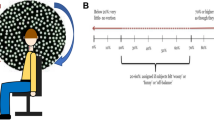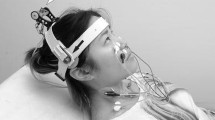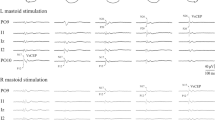Summary
The interaction of the cervico-ocular reflex (COR) and the vestibulo-ocular reflex (VOR) was studied in 20 human Subjects (Ss) during application of synergistic and antagonistic combinations of neck and vestibular stimuli, and during two different psychophysical tasks related to the Ss' self-motion sensation. Slow and quick eye movement responses were analyzed separately. Neck stimulation produced by horizontal rotation of the trunk about the stationary head elicited slow COR eye movements of very low gain; COR direction was anticompensatory, unlike the compensatory one of the VOR. During either a synergistic combination of neck and labyrinthine stimuli (head rotation on stationary trunk) or an antagonistic combination (head-to-trunk rotation counter to head-in-space rotation), the resulting slow eye movements were slightly larger than those during labyrinthine stimulation alone (whole body rotation). This weak neck contribution could be described by a directionally non-specific enhancement of VOR gain and a linear summation of VOR and COR slow phases. These effects were essentially independent of whether the Ss estimated the magnitude of their head turning or trunk turning in space. If Ss were estimating their trunk turning, neck stimulation also evoked quick eye movements, but these were small and hardly affected the VOR quick phases during the combined stimulations. In contrast, if Ss estimated their head turning, neck stimulation evoked large quick phases, which interfered with the quick phases of the VOR; during the synergistic combination of head and neck stimuli. COR quick phases added to those of the VOR, thereby shifting the gaze in the direction of head rotation (reorientation of gaze). With the antagonistic combination they subtracted, so that the VOR slow phase could compensate the head rotation in space (stabilization of gaze). These findings suggest that (1) the slow phase of the COR has no functional significance in intact humans and (2) the quick phase of the COR plays a role for both stabilization and reorientation of gaze depending on the behavioural context.
Similar content being viewed by others
References
Bárány R (1906) Augenbewegungen, durch Thoraxbewegungen ausgelöst. Zbl Physiol 20:298–302
Bárány R, (1918/19) Über einige Augen- und Halsmuskelreflexe bei Neugeborenen. Acta Otolaryngol 1:97–102
Barlow D, Freedman W (1980) Cervico-ocular reflex in the normal adult. Acta Otolaryngol 89:487–496
Barmack NH, Nastos MA, Petorossi VE (1981) The horizontal and the vertical cervico-ocular reflexes of the rabbit. Exp Brain Res 224:261–278
Barmack NH, Draicchio F, Errico P, Ferraresi A, Petorossi VE (1985) Characteristics of the combination of the vestibulo- and cervico-ocular reflexes in the control of rabbit eye movements. J Physiology 369:47P
Barnes GR, Forbat LN (1979) Cervical and vestibular afferent control of oculomotor response in man. Acta Otolaryngol 88:79–87
Barr CC, Schultheis LW, Robinson DA (1976) Voluntary, nonvisual control of the human vestibulo-ocular reflex. Acta Otolaryngol 81:365–375
Bikeles G, Ruttin E (1915) Uber die reflektorischen kompensatorischen Augenbewegungen bei beidseitiger Ausschaltung des N. vestibularis. Neurol Zentralbl 34:807–810
Bles W, de Jong JMBV (1982) Cervico-vestibular and visuovestibular interaction: self-motion perception, nystagmus, and gaze shift. Acta Otolaryngol 94:61–72
Bronstein AM, Hood JD (1986) The cervico-ocular reflex in normal subjects and patients with absent vestibular function. Brain Res 373:399–408
de Kleijn A (1921) Tonische Labyrinth- und Halsreflexe auf den Augen. Pflügers Arch 186:82–97
de Kleijn A, Stenvers HW (1941) Tonic neck reflexes on the eye muscles in man. Proc K Ned Akad Wet 44:385–396
Dichgans J, Bizzi E, Morasso P, Tagliasco V (1973) Mechanisms underlying recovery of eye-head coordination following bilateral labyrinthectomy in monkeys. Exp Brain Res 18:548–562
Doerr M, Hong SH, Thoden U (1984) Eye movements during active head turning with different vestibular and cervical input. Acta Otolaryngol 98:14–20
Doerr M, Leopold HC, Thoden U (1981) Vestibulo-ocular reflex (VOR), cervico-ocular reflex (COR) and its interaction in active head movements. Arch Psychiat Nervenkr 230:117–127
Fischer MH (1924) In Sachen des Drehnystagmus. Acta Otolaryngol 7:495–504
Frenzel H (1928) Rucknystagmus als Halsreflex und Schlagfeldverlagerung des labyrinthären Drehnystagmus durch Halsreflexe. Z Hals-Nasen-Ohrenheilkd 21:177–185
Frenzel H (1930) Halsreflektorisches Augenrucken von vestibulärer Schlagform bei vollständig oder nahezu vollständig Labyrinthlosen (Drehunerregbaren). Passow-Schäfer Beitr Hals-, Nasen-, Ohrenheilk 28:305–310
Fuller JH (1980) The dynamic neck-eye reflex in mammals. Exp Brain Res 41:29–35
Gauthier GM, Hofferer JM (1976) Eye tracking of self-moved targets in the absence of vision. Exp Brain Res 26:121–139
Gottschalk C, Grüsser O-J, Lindau (1978) Tracking movements of the eyes elicited by auditory stimuli at constant angular velocity. Pflügers Arch 377 (Suppl) R46
Jürgens R, Mergner T, Schmidt-Burgk W (1982) Modification of VOR slow and quick components by neck stimulation and turning sensation. In: Roucoux A, Crommelinck M (eds) Physiological and pathological aspects of eye movements. Junk Publishers, The Hague, pp 365–370
Kasai T, Zee DS (1978) Eye-head coordination in labyrinthinedefective human beings. Brain Res 144:123–141
Leopold HC, Doerr M, Thoden U (1983) Cervico-ocular responses (COR) during slow sinusoidal head movements in subjects with bilateral labyrinthine lesions. Arch Psychiat Nervenkr 233:439–447
Meiry JL (1971) Vestibular and proprioceptive stabilization of eye movements. In: Bach-y-Rita P, Collins C, Hyde JE (eds) The control of eye movements. Academic Press, New York London, pp 483–496
Mergner T, Nardi GL, Becker W, Deecke L (1983) The role of canal-neck interaction for the perception of horizontal trunk and head rotation. Exp Brain Res 49:198–208
Philipszoon AJ, Bos JH (1963) Neck torsion nystagmus. Pract Oto-Rhino-Laryng 25:339
Stevens SS (1956) The direct estimation of sensory magnitudesloudness. Am J Psychol 69:1–25
Takemori S, Suzuki JI (1971) Eye deviations from neck torsion in humans. Ann Otol 80:439–444
Vidal PP, Roucoux A, Berthoz A (1982) Horizontal eye position-related activity in neck muscles of the alert cat. Exp Brain Res 46:448–453
Zambarbieri D, Schmid R, Prablanc C, Magenes G (1981) Characteristics of eye movements evoked by the presentation of acoustic targets. In: Fuchs AF, Becker W (eds) Progress in oculomotor research. Elsevier North Holland, New York Amsterdam Oxford, pp 559–566
Author information
Authors and Affiliations
Additional information
Supported by DFG grants Ju 163/1-1 and Me 715/1-2
Rights and permissions
About this article
Cite this article
Jürgens, R., Mergner, T. Interaction between cervico-ocular and vestibulo-ocular reflexes in normal adults. Exp Brain Res 77, 381–390 (1989). https://doi.org/10.1007/BF00274995
Received:
Accepted:
Issue Date:
DOI: https://doi.org/10.1007/BF00274995




